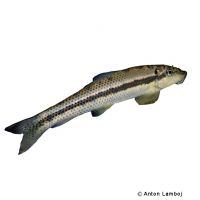Chinese Algae Eater (Gyrinocheilus aymonieri)
| Chinese Algae Eater Gyrinocheilus aymonieri | |
|---|---|
| Name | Chinese Algae Eater |
| Name Lat. | Gyrinocheilus aymonieri |
| Family | Algae Eaters |
| Family lat. | Gyrinocheilidae |
| Order | Carps |
| Order lat. | Cypriniformes |
| Origin | Southeast Asia |
| Habitat | Streams, rice paddies |
| Diet | Limnivore |
| pH | 6.0-8.0 |
| Behavior | Territorial |
| Keeping | Individual, group |
| Care Level | Moderate |
| Reproduction | Substrate spawner |
| Breeding | None reported |
| Life Span | 5-10 years |
| Protection | No |
| Metric Units | |
| Size | 20-28 cm |
| Temperature | 22-26 °C |
| Hardness | 2-20 °dH |
| Aquarium | 120 cm / 240 l |
| US Units | |
| Size | 7.9"-11" |
| Temperature | 72-79 °F |
| Hardness | 36-356 ppm |
| Aquarium | 65 gal |
Distribution and habitat
The distribution area of the Siamese Sucker Loach is the northern Malay Peninsula, the Mae Klong Basin (Thailand) and the Mekong and Chao Phraya River basins (Thailand, Laos, Cambodia), where they mostly live in oxygen-rich rivers with strong currents but also flooded rice fields.
Maintenance
The aquarium should have varied planting and a stony, rocky substrate. Moderate to strong current promotes their well-being.
No ammonia, ammonium and nitrite should be detectable, the nitrate value should not exceed 100 mg/l. To ensure the water quality and oxygen content, a filter and heater adapted to the aquarium size is required, as well as lighting for the species-appropriate day-night rhythm of the animals.
Diet
They eat the vegetable cover (growth) of stones, wood, plants, etc. and the microorganisms contained therein. In addition, zucchini and avocado pieces, blanched peas and algae leaves should be fed, as well as pellets and catfish tablets. In addition, some animal food, such as cyclops and daphnia, which is also accepted in frozen form. Younger animals thus act as "disc cleaners" or "algae eaters".
A regular and varied diet promotes health and increases resistance. Only as much should be fed as is eaten immediately (in a maximum of 10 minutes).
Behaviour and compatibility
Fish up to a size of 8-10 cm are well suited for a community tank. Larger and older animals often behave territorially and should only be kept in larger and richly structured tanks.
In principle, only mutually compatible fish species with similar requirements for water quality and water temperature may be socialized.
Sex dimorphism
There are no known external distinguishing characteristics.
Reproduction and breeding
There are no known reports of successful breeding in the aquarium. In Southeast Asia they are bred in ponds.
Important
The peculiarity of not taking in the breathing water with the mouth but sucking it in through small openings in the upper part of the gill slits (up to 200 times per minute) enables the Siamese Sucking Loaches to use the mouth exclusively as a sucking organ and for food intake
If the temperature drops below 20 °C, the fish stop eating algae.
The well-being of the fish should be checked regularly. The temperature should be checked daily, the pH value, hardness and nitrate value at least every 14 days. Regular partial water changes are recommended, even if the contaminant level has not yet reached the upper limit. Sudden changes in water quality should be avoided. Newly introduced fish must be accustomed slowly to the water in the aquarium.
Further literature can be found in your pet store.
References
Text: petdata; Image: Anton Lamboj
Source: BMELV (1998): Tierschutzgutachten - Haltung von Zierfischen (Süßwasser); RIEHL & BAENSCH (2006): Aquarien Atlas Bd. 1, Mergus Verlag; ENGELMANN (2005): Zootierhaltung - Tiere in menschlicher Obhut: Fische, Verlag Harri Deutsch
- Gemäß § 21 Abs. 5 Tierschutzgesetz idgF
